My fascination with a painting of Ophelia dated 1851-1852 by John Everett Millais
Author: Distil Ennui | Post Date: 04-09-2022I first saw this painting when it was on an exhibition tour in Japan arranged by Tate Britain. the painting depicts a scene from Shakespeare's Hamlet, Act IV, Scene vii, in which Ophelia, driven out of her mind when her father is murdered by her lover Hamlet, falls into a stream and drowns. Although conjecture suggests she killed herself out of grief induced madness, but history has somehow re-written the story. The delicacy of her expression and skin tones set against the lush floral depictions to me were astonishing, on researching the piece it would seem the artist suffered greatly in its creation striking a resonance within me.
By painting with close observation of nature. Millais quickly found, however, that such intense study was not without problems, and was moved to remark in a letter to Mrs Thomas Combe,
' My martyrdom is more trying than any I have hitherto experienced. The flies of Surrey are more muscular, and have a still greater propensity for probing human flesh ... I am threatened with a notice to appear before a magistrate for trespassing in a field and destroying the hay ... am also in danger of being blown by the wind into the water, and becoming intimate with the feelings of Ophelia when that Lady sank to muddy death, together with the (less likely) total disappearance, through the voracity of the flies ... Certainly the painting of a picture under such circumstances would be a greater punishment to a murderer than hanging.' (J.G. Millais I, pp.119–20)
The figure of Ophelia was added afterwards. The model, Elizabeth Siddal, a favourite of the Pre-Raphaelites who later married Rossetti, was required to pose over a four month period in a bath full of water kept warm by lamps underneath. The lamps went out on one occasion, causing her to catch a severe cold. Her father threatened the artist with legal action until he agreed to pay the doctor's bills.
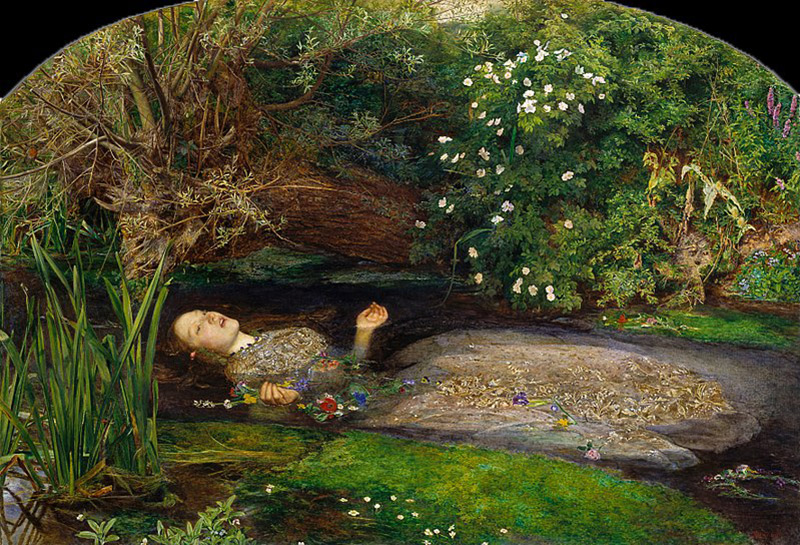
Sir John Everett Millais, Ophelia 1851–1852 courytesy Tate Britain.
It is beautifully painted in the style of the Pre-Raphaelite Brotherhood; later known as the Pre-Raphaelites. A group of English painters, poets, and art critics, founded in 1848 by William Holman Hunt, John Everett Millais, Dante Gabriel Rossetti, William Michael Rossetti, James Collinson, Frederic George Stephens and Thomas Woolner who formed a seven-member "Brotherhood" modelled in part on the Nazarene movement.
There, on the pendent boughs her coronet weeds
Clambering to hang, an envious sliver broke;
When down her weedy trophies and herself
Fell in the weeping brook. Her clothes spread wide,
And, mermaid-like, awhile they bore her up;
Which time she chanted snatches of old tunes,
As one incapable of her own distress,
Or like a creature native and indued
Unto that element; but long it could not be
Till that her garments, heavy with their drink,
Pull'd the poor wretch from her melodious lay
To muddy death.
Shakespeare's Hamlet, Act IV, Scene vii
I had never attempted a figurative piece before, knowing full well the complexities of applying the medium of water to such a large scale work. To date I had been creating still life and Vanitas works underwater, documenting them on large format analogue cameras. To me attempting such a large and technically sophisticated piece would be madness.
Personal events however did bring me to this tragic story and my wish to explore the subject and interpret it based on my experiences and process. The resulting works pay I believe respectful homage to the Ophelia in John Everett Millais painting and indeed I exhibited them in 2012 at 'A beautiful announcement of death' Pertwee Anderson & Gold Gallery, London.
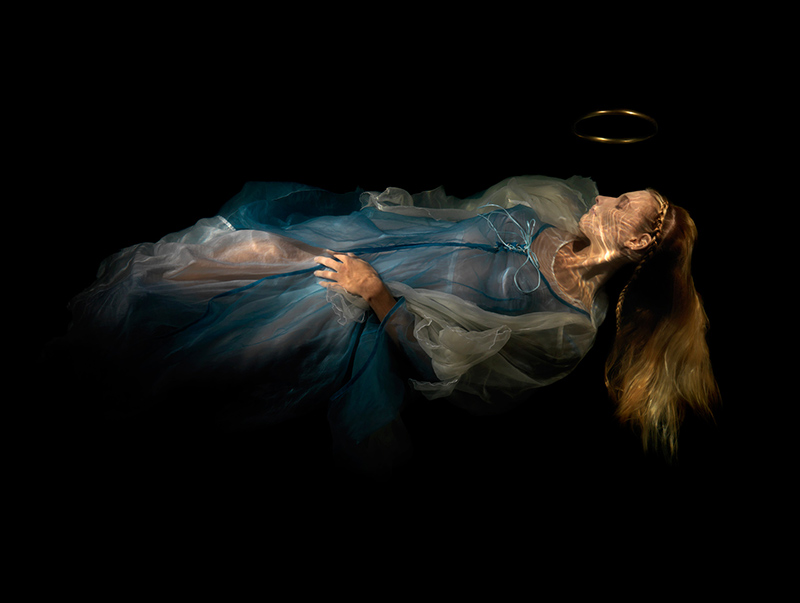
'Witness' , chromogenic print 180 x 135 cms. Pertwee Anderson & Gold Gallery, London.
In the original Ophelia lays surrounded by symbolic flowers chosen specifically and were depicted with painstaking botanical detail. The roses near Ophelia's cheek and dress, and the field rose on the bank, may allude to her brother Laertes calling her 'rose of May'. The willow, nettle and daisy are associated with forsaken love, pain, and innocence. Pansies refer to love in vain. Violets, which Ophelia wears in a chain around her neck, stand for faithfulness, chastity or death of the young, any of which meanings could apply here. The poppy signifies death. Forget-me-nots float in the water. Millais wrote to Thomas Combe in March 1852: ‘Today I have purchased a really splendid lady's ancient dress - all flowered over in silver embroidery - and I am going to paint it for “Ophelia”. You may imagine it is something rather good when I tell you it cost me, old and dirty as it is, four pounds’
I chose a different direction by placing Ophelia alone in the scene surround by a deep dark void, this was my own choice to reference a profound sense of loss. However I wanted this maiden surrounded with flowers all the same, so in mindful reverence I created a large body of floral Vanitas works at the same time, to be hung all around my Ophelia filling the space with floral tributes.
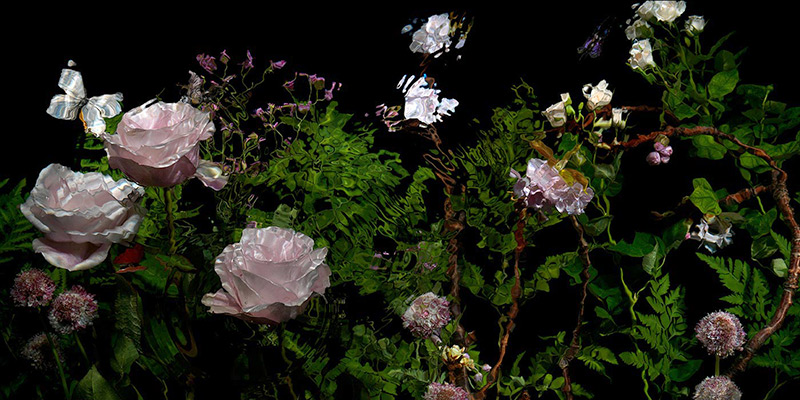
'Riverbrook with roses' dated 2012. 160 x 80cms chromogenic print.
There were two Ophelia scenes, one alone in each of the main gallery rooms, here is the second. As before every element of the scene is hand constructed from the pure gold halo to the fine couture dresses, 'Witness' in a silk blue simple double layered dress and below 'Turned from heavens door' in a lavish tulle silk gown with 1,000's of pearls hand sewn into it with fine embroidery; the dress alone took over 500 hours to create by hand.
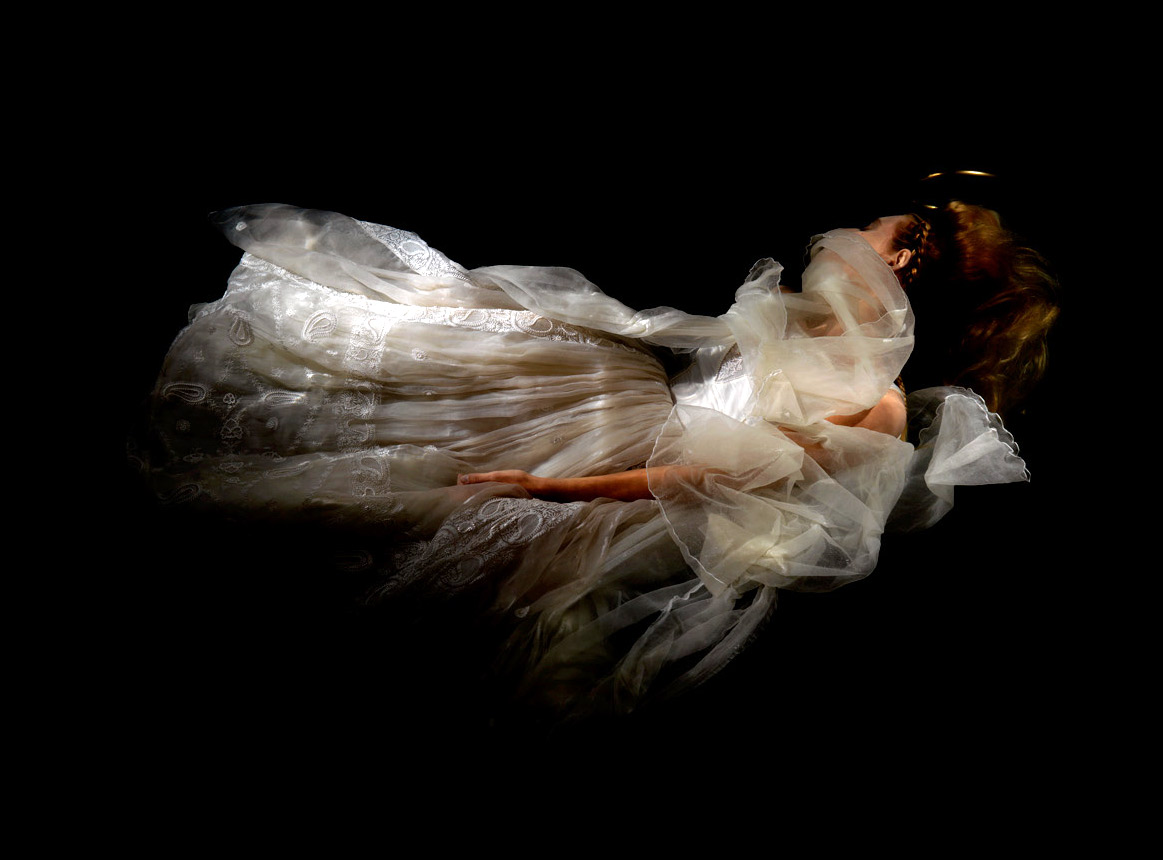
'Turned from heavens door', chromogenic print 180 x 135 cms. Pertwee Anderson & Gold Gallery, London.

'Turned from heavens door', chromogenic print 180 x 135 cms, private collection.
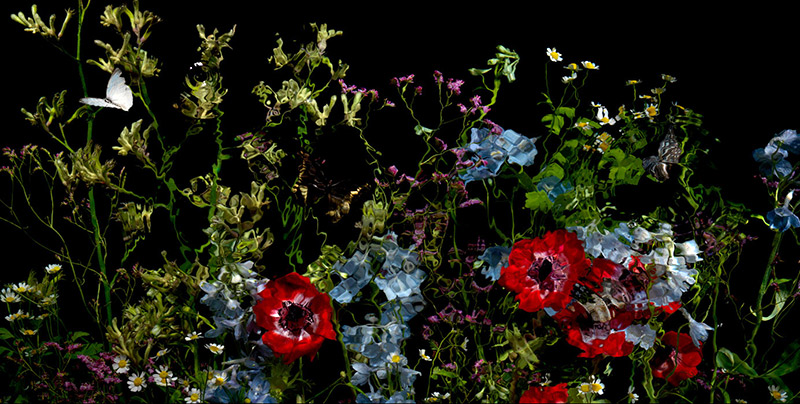
'Riverbrook with peony' dated 2012. 160 x 80cms chromogenic print.
The exhibition was completed with the downstairs gallery space, sitting centre stage a 500 kilogram stainless steel vitrine case filled with water and inside a floating skull of a woman veiled in black silk. Her head was invisibly suspended centrally within the volume of water with the silk wafting around her face within the vitrine cases never endging currents. The vitrine case had its own lighting and management system with which it cast watery light caustics across the floor and walls of the space, around this central piece were installed a series of momento mori underwater photographic works that completed a very surreal exhibition installation.

'Veiled skull with flowers' dated 2012
You can download the exhibition catalogue HERE.
I hope you found this journal entry informative, please stay connected.
Join the mailing list.. Register
Telegram Channel.. DistilEnnui
Instagram.. AJHamilton.Artist
Twitter.. DistilEnnui
Support on Patreon.. SustainableArt